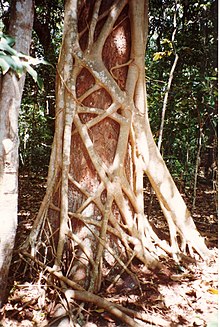Ficus watkinsiana
| Ficus watkinsiana | |
|---|---|

| |
| Ficus watkinsiana on Syzygium hemilampra, Iluka, New South Wales, | |
| Scientific classification | |
| Kingdom: | Plantae |
| Clade: | Tracheophytes |
| Clade: | Angiosperms |
| Clade: | Eudicots |
| Clade: | Rosids |
| Order: | Rosales |
| Family: | Moraceae |
| Genus: | Ficus |
| Species: | F. watkinsiana
|
| Binomial name | |
| Ficus watkinsiana | |
| Synonyms[1] | |
| |
Ficus watkinsiana, commonly known as strangler fig, Watkins' fig, nipple fig or the green-leaved Moreton Bay fig is a hemiepiphytic fig that is endemic to Australia. The species exists in three populations—one in northeast Queensland and the others in southeast Queensland and northeast New South Wales.[1] It also has been introduced to Kauai island (Hawaiʻi).[2]
The pollinator of this species in Australia is Pleistodontes nigriventris (Girault).[2] On Kauai island, Port Jackson fig wasps (Pleistodontes imperialis) are able to do the job as substitute pollinators.[2]
Description[]
Ficus watkinsiana is a monoecious tree which grows up to 50 m (160 ft) tall. Its leaves are 51–217 mm (2.0–8.5 in) long and 26–97 mm (1.0–3.8 in) wide. Its figs (syconia) are deep purple to black in colour, 24–37 mm (0.94–1.46 in) long and 18–29 mm (0.71–1.14 in) in diameter. It begins life as a hemiepiphyte.[1]
Uses[]
The figs (synconia) are black or almost black and spotted when ripe. They are of fair quality in flavour.[3]
References[]
- ^ a b c Dixon, Dale J. (2003). "A taxonomic revision of the Australian Ficus species in the section Malvanthera (Ficus subg. Urostigma: Moraceae)" (PDF). Telopea. 10 (1): 125–53. doi:10.7751/telopea20035611. Archived from the original (PDF) on 4 October 2009.
- ^ a b c Jared Bernard et al.: New Species Assemblages Disrupt Obligatory Mutualisms Between Figs and Their Pollinators. In: Front. Ecol. Evol., 19 November 2020. doi:10.3389/fevo.2020.564653. See also:
- Jared Bernard: Figs show that nonnative species can invade ecosystems by forming unexpected partnerships. On: The Conversation. 19 January 2021. Also on Sciencealert
- ^ Lindsay, Lenore (March 1992). "Fancy a feast? Try a fig". Australian Plants. 16 (130): 251–52.
- Rosales of Australia
- Trees of Australia
- Flora of Queensland
- Flora of New South Wales
- Ficus sect. Malvanthera
- Epiphytes
- Moraceae stubs
- Australian rosid stubs
- Fruit tree stubs